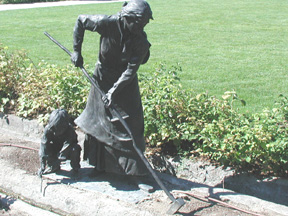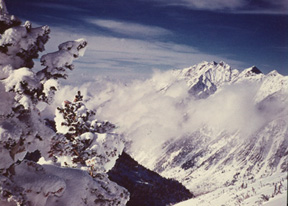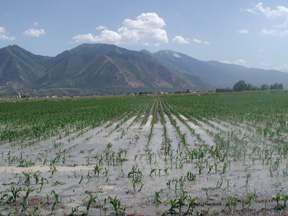WEF/AWWA Joint Management Conference
Salt Lake City Down Town Marriott Hotel
Welcoming Remarks
LeRoy W. Hooton, Jr., Director Salt Lake City Department of Public Utilities
Posted March 2, 2006
|
Understanding that many of you in the audience are not familiar with this region of the United States, I’d like to speak about Utah and Salt Lake City’s water history. Our history began with the 1847 arrival of the Mormon pioneers in the Salt Lake Valley. Located a few blocks from here is the Brigham Young Historic Park where there is a figure of a pioneer woman with her child at her side working the earth along side a small irrigation ditch. The image is symbolic of the struggle the early pioneers endured to first survive and then prosper in the Salt Lake valley; and how the successful practice of irrigation shaped the history of Utah and the western United States.
The pioneer settlers carved out the State of Deseret in a large area of the West that was claimed by Mexico bound by the Oregon Territory on the north; the Green River on the east; Mexico on the south and the Sierras on the west, including San Diego as a seaport to the Pacific Ocean. At the end of the American – Mexican War in 1848 the area became a territory of the United States. During this early period ward bishops were responsible for communal ditch construction and water management.
In 1850, Congress established the Territory of Utah and adjusted the boundary to that of the state of Utah. Salt Lake City was incorporated in 1851 and took over the control of water within its corporate limits.
In 1896, the Territory of Utah was granted statehood.
Utah is the second driest state with a statewide average of 13 inches of precipitation with very little occurring during the summer growing season. Nevada is the driest with 9 inches of water.
Located in Nevada and western Utah is the Great Basin desert. If you drive west from here, there is nothing but desert for 500 miles until you reach the Sierra Nevada mountain range. Great Basin Desert vegetation grows low and homogeneous, often with a single dominant species of brush for miles. Typical shrubs are Big Sagebrush, Blackbush, Mormon-tea and greasewood.
So how did the pioneer settlers survive in the Salt Lake valley and later establish hundreds of other communities as part of the colonization of the Great Basin?
|
A mountain range traverses the state of Utah from the south to the north. Also, there is a large mountain range located in the northeastern part of the state in the Uintah Basin.
In the northern mountain ranges of the state the precipitation averages 26 inches of water. As you go southward, the precipitation lessens to 15-17 inches. The west desert and Colorado Plateau precipitation averages about 10 inches.
The Salt Lake valley receives about 16 inches with very little of this occurring during the summer and fall growing season. Without irrigation, crops and greenery as we know it would not exist. However, the Wasatch Mountains located along the eastern boundary of the valley, receive large amounts of precipitation in the form of snow during the winter months. Brighton located in Big Cottonwood Canyon at the 8750 foot elevation, receives 42.66 inches of water in Snow Water Equivalent (SWE) and Alta, located in Little Cottonwood Canyon at the 8840 foot elevation, receives 53.56.
In Utah water managers and farmers anxiously watch the winter snowpack to determine if there will be adequate water supply for the coming summer months.
There are differing descriptions of the pioneer’s impression of the Salt Lake valley. Most of the descriptions were similar to the one of Orson Whitney:
“Aside from its scenic splendor…there was little to invite and much to repel in the prospect to their view. On all sides a seemingly interminable waste of sagebrush bespangled with sunflowers, the paradise of the lizard, the cricket and the rattlesnake.”
Based on the early descriptions of the Salt Lake valley and our contemporary understanding of the Great Basin Desert, it could be concluded that this area was an undesirable place to live; but with the successful practice of irrigation the sagebrush desert was transformed to productive farmlands and a beautiful city was built at the foot of the Wasatch Mountains.
Under the leadership of Mormon leader Brigham Young the practice of irrigation was perfected and institutionalized allowing the colonization of the Great Basin. Over 365 colonies were settled in the basin using the same irrigation practices.
By 1860 there were over 1,000 miles of ditches in Utah and by 1910 there were a million acres of irrigated land in Utah.
The pioneer’s domestic water was dipped from the open ditches. Some had springs or artesian wells; and others dug shallow wells for the household water use.
|
In 1902 President Teddy Roosevelt signed the Reclamation Act. Under the Bureau of Reclamation (BOR) hundreds of dams and reservoirs were constructed providing annually thousands of acre-feet of municipal and irrigation water to reclaim the arid West. Additionally hydropower plants have produced billions of kilowatt hours of electricity. In Utah 14 projects were constructed providing 240,000 acre-feet of M&I water supply for nearly a million people and 430,000 acre-feet of irrigation water for 330,000 acres of farmland.
In 1929 Mayor Bowman with the slogan “A City can never be greater than its water supply,” formed a citizen’s advisory board to study increasing the city’s water supply to serve 400,000 people. The water supply developed under this study increased Salt Lake City’s water supply 250 percent and provided enough water to meet growth within Salt Lake County to the end of the 20th century. Participating in the Provo River Project and the construction of Deer Creek Reservoir was the cornerstone of this water development endeavor.
In 1977 Salt Lake City requested the Metropolitan Water District of Salt Lake City to petition for 20,000 acre-feet of water from the Central Utah Project. Additionally 7900 acre-feet of water were developed with the Little Dell Project in 1992. These water supplies with water conservation and wastewater reuse will provide the City an adequate water supply well beyond the year 2025.
Utah’s water history is both instructive and inspiring given the challenges of living in the second driest state in the union. Water resources developed over its 159 years of history by the pioneers, private citizens, mutual irrigation companies, local and state government and the BOR have allowed us to grow and prosper today and to face the future with optimism.
In conclusion I hope that you enjoy the conference and you visit Salt Lake City again in the future.
Return to Home Page http://www.slcclassic.com/utilities/


